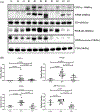Restrictive allograft syndrome vs bronchiolitis obliterans syndrome: Immunological and molecular characterization of circulating exosomes
- PMID: 34602310
- PMCID: PMC11019888
- DOI: 10.1016/j.healun.2021.09.001
Restrictive allograft syndrome vs bronchiolitis obliterans syndrome: Immunological and molecular characterization of circulating exosomes
Abstract
Background: Chronic lung allograft dysfunction in lung transplant recipients (LTxRs) has 2 phenotypes: obstructive bronchiolitis obliterans syndrome (BOS) and restrictive allograft syndrome (RAS). Our goal was to define distinct immunologic markers of exosomes from LTxRs with BOS or RAS.
Methods: Plasma was collected from LTxRs with BOS (n = 18), RAS (n = 13), and from stable LTxRs (n = 5). Antibodies to lung self-antigens (SAgs) were determined by ELISA. Exosomes were isolated by ultracentrifugation. Donor specific antibodies to HLA were quantified using Luminex. Exosomes were characterized for lung SAgs, transcription factors, 20S proteasome, HLA class I and II, and polymeric immunoglobulin receptor protein using western blot. Exosome miRNA was analyzed using NanoString. The exosome-induced immune response was determined in mice.
Results: LTxRs with RAS, but not BOS, had donor specific antibodies at diagnosis. CIITA, NFkB, polymeric immunoglobulin receptor protein, 20S proteasome, HLA-DQ, and HLA-DR were significantly higher in RAS exosomes than in BOS exosomes. RAS plasma had high levels of proinflammatory cytokines and distinct exosomal miRNA. Immunization of C57BL/6 mice with RAS exosomes showed severe inflammation and peribronchial fibrosis, whereas BOS exosomes induced patchy inflammation and fibrosis.
Conclusion: LTxRs with BOS or RAS had exosomes with distinct molecular and immunologic profiles. RAS samples had a higher concentration of proinflammatory factors, HLA class II, lung SAgs, and antibodies to HLA class II molecules, indicating severe allograft injury. Mice immunized with RAS exosomes developed lesions in airways, pleura, interlobular septum, and alveoli, whereas BOS exosomes induced mild to patchy inflammation with lung fibrosis.
Keywords: bronchiolitis obliterans syndrome; exosomes; lung transplantation; restrictive allograft syndrome.
Copyright © 2021 International Society for Heart and Lung Transplantation. Published by Elsevier Inc. All rights reserved.
Conflict of interest statement
Declaration of competing interest The authors declare no conflict of interest. All authors have reviewed and approved the manuscript and have contributed in a substantial and intellectual manner to the work.
Figures






Comment in
-
The emerging role of exosomal cargo in allograft rejection after lung transplantation.J Heart Lung Transplant. 2022 Jan;41(1):34-36. doi: 10.1016/j.healun.2021.09.015. Epub 2021 Oct 3. J Heart Lung Transplant. 2022. PMID: 34756654 No abstract available.
Similar articles
-
Distinct molecular and immunological properties of circulating exosomes isolated from pediatric lung transplant recipients with bronchiolitis obliterans syndrome - a retrospective study.Transpl Int. 2020 Nov;33(11):1491-1502. doi: 10.1111/tri.13720. Epub 2020 Sep 5. Transpl Int. 2020. PMID: 33448479 Free PMC article.
-
Decline in Club Cell Secretory Proteins, Exosomes Induction and Immune Responses to Lung Self-antigens, Kα1 Tubulin and Collagen V, Leading to Chronic Rejection After Human Lung Transplantation.Transplantation. 2021 Jun 1;105(6):1337-1346. doi: 10.1097/TP.0000000000003428. Transplantation. 2021. PMID: 32890135 Free PMC article.
-
Circulating exosomes with lung self-antigens as a biomarker for chronic lung allograft dysfunction: A retrospective analysis.J Heart Lung Transplant. 2020 Nov;39(11):1210-1219. doi: 10.1016/j.healun.2020.07.001. Epub 2020 Jul 7. J Heart Lung Transplant. 2020. PMID: 32713614 Free PMC article.
-
The role of donor-derived exosomes in lung allograft rejection.Hum Immunol. 2019 Aug;80(8):588-594. doi: 10.1016/j.humimm.2019.03.012. Epub 2019 Mar 18. Hum Immunol. 2019. PMID: 30898684 Free PMC article. Review.
-
Bronchiolitis obliterans syndrome and restrictive allograft syndrome after lung transplantation: why are there two distinct forms of chronic lung allograft dysfunction?Ann Transl Med. 2020 Mar;8(6):418. doi: 10.21037/atm.2020.02.159. Ann Transl Med. 2020. PMID: 32355862 Free PMC article. Review.
Cited by
-
Downregulation of Tumor Suppressor Gene LKB1 During Severe Primary Graft Dysfunction After Human Lung Transplantation: Implication for the Development of Chronic Lung Allograft Dysfunction.Transplantation. 2025 Mar 1;109(3):476-483. doi: 10.1097/TP.0000000000005172. Epub 2024 Sep 4. Transplantation. 2025. PMID: 39228019 Free PMC article.
-
miRNA-19b-3p Stimulates Cardiomyocyte Apoptosis Induced by Myocardial Ischemia Reperfusion via Downregulating PTEN.Dis Markers. 2021 Dec 16;2021:9956666. doi: 10.1155/2021/9956666. eCollection 2021. Dis Markers. 2021. PMID: 34956421 Free PMC article.
-
Markers of Bronchiolitis Obliterans Syndrome after Lung Transplant: Between Old Knowledge and Future Perspective.Biomedicines. 2022 Dec 17;10(12):3277. doi: 10.3390/biomedicines10123277. Biomedicines. 2022. PMID: 36552035 Free PMC article. Review.
-
Extracellular vesicles: a potential new player in antibody-mediated rejection in lung allograft recipients.Front Transplant. 2023 Sep 4;2:1248987. doi: 10.3389/frtra.2023.1248987. eCollection 2023. Front Transplant. 2023. PMID: 38993876 Free PMC article.
-
Late-Onset Exudative Pleural Effusions Without Concomitant Airway Obstruction or Lung Parenchymal Abnormalities: A Novel Presentation of Chronic Lung Allograft Dysfunction.Transpl Int. 2024 Jan 26;37:12395. doi: 10.3389/ti.2024.12395. eCollection 2024. Transpl Int. 2024. PMID: 38357217 Free PMC article.
References
-
- Verleden GM, Raghu G, Meyer KC, et al. A new classification system for chronic lung allograft dysfunction. J Heart Lung Transplant 2014;33:127–33. - PubMed
-
- Verleden GM, Glanville AR, Lease ED, et al. Chronic lung allograft dysfunction: Definition, diagnostic criteria, and approaches to treatment-A consensus report from the Pulmonary Council of the ISHLT. J Heart Lung Transplant 2019;38:493–503. - PubMed
-
- Barker AF, Bergeron A, Rom WN, et al. Obliterative bronchiolitis. N Engl J Med 2014;370:1820–8. - PubMed
-
- Chamberlain D, Maurer J, Chaparro C, et al. Evaluation of transbronchial lung biopsy specimens in the diagnosis of bronchiolitis obliterans after lung transplantation. J Heart Lung Transplant 1994;13:963–71. - PubMed
-
- Sato M, Waddell TK, Wagnetz U, et al. Restrictive allograft syndrome (RAS): a novel form of chronic lung allograft dysfunction. J Heart Lung Transplant 2011;30:735–42. - PubMed
Publication types
MeSH terms
Grants and funding
LinkOut - more resources
Full Text Sources
Medical
Research Materials

